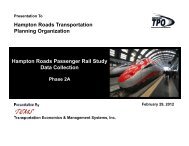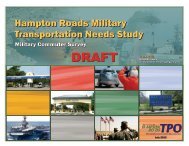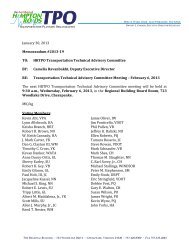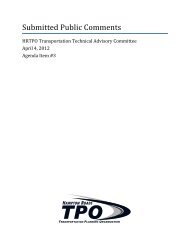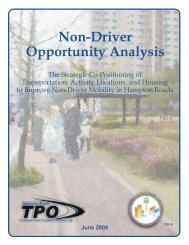Hampton Roads Regional Bridge Study
Hampton Roads Regional Bridge Study
Hampton Roads Regional Bridge Study
You also want an ePaper? Increase the reach of your titles
YUMPU automatically turns print PDFs into web optimized ePapers that Google loves.
BRIDGE FUNDING 37<br />
BRIDGE FUNDING<br />
Similar to other aspects of transportation, funds for constructing and<br />
maintaining bridges are limited. Funding for bridge projects comes from a<br />
variety of federal, state, and local sources. In some cases tolls are also<br />
used to fund bridge construction projects. This section details each of<br />
these bridge funding sources.<br />
FEDERAL BRIDGE FUNDING<br />
On July 6, 2012, the new federal surface transportation funding and<br />
authorization bill was signed into law. The Moving Ahead for Progress in<br />
the 21st Century Act (MAP-21) will change how bridge rehabilitation and<br />
reconstruction is funded on the federal level.<br />
The primary federal program for funding bridge projects prior to MAP-21<br />
was the Highway <strong>Bridge</strong> Program. This program, which was created by<br />
Congress in 1978 as the Highway <strong>Bridge</strong> Replacement and Rehabilitation<br />
Program (HBRRP), provided dedicated funding to states to enable them to<br />
improve the condition of highway bridges.<br />
Recent federal funding for the Highway <strong>Bridge</strong> Program was determined<br />
by the Safe, Accountable, Flexible, Efficient Transportation Equity Act: A<br />
Legacy for Users (SAFETEA-LU) legislation. Between $4.6 and $6.0<br />
billion was authorized each year to the Highway <strong>Bridge</strong> Program over the<br />
life of SAFETEA-LU and its extensions. This includes the base<br />
apportionment and additional apportionments provided to the Highway<br />
<strong>Bridge</strong> Program from Equity Bonus Distributions, which are described<br />
further later in this section.<br />
Allocating federal bridge funds to each state was done through a complex<br />
formula. The amount of Highway <strong>Bridge</strong> Program funding allocated from<br />
the base apportionment to each state was determined by each state’s<br />
relative share of the total costs to rehabilitate or replace all eligible<br />
deficient bridges. <strong>Bridge</strong>s are considered eligible for federal bridge<br />
replacement funds if they are classified as structurally deficient or<br />
functionally obsolete and have a sufficiency rating of less than 50.0, and<br />
are considered eligible for federal bridge rehabilitation funds if they are<br />
classified as structurally deficient or functionally obsolete and have a<br />
sufficiency rating between 50.0 and 80.0. <strong>Bridge</strong>s that have been<br />
constructed or had a major rehabilitation within the last ten years,<br />
however, are not eligible for Highway <strong>Bridge</strong> Program funds since they<br />
cannot be classified as structurally deficient or functionally obsolete (the<br />
Ten Year Rule).<br />
<strong>Bridge</strong>s eligible for federal funding throughout each state were divided<br />
into one of four groups based on whether it was eligible for replacement<br />
or rehabilitation and whether the bridge was on a federal-aid route, which<br />
generally includes all roadways that are not classified as local or rural<br />
minor collector roadways.<br />
For each of these four bridge groups – federal-aid route eligible for<br />
replacement, federal-aid route eligible for rehabilitation, non-federal-aid<br />
route eligible for replacement, and non-federal-aid route eligible for<br />
rehabilitation – the total deck area of all bridges throughout the state was<br />
summed together and multiplied by the state’s three-year average unit<br />
construction cost for each group. According to FHWA, Virginia’s average<br />
unit cost for each group in Federal Fiscal Years (FFY) 2008 – 2010 was:<br />
<br />
<br />
BRIDGE FUNDING SUMMARY<br />
Highway <strong>Bridge</strong> Program funding apportioned<br />
to the state of Virginia in 2012.<br />
($113 million in 2007)<br />
Virginia rank among the 50 states and D.C.<br />
in terms of Highway <strong>Bridge</strong> Program<br />
apportionments in 2012.<br />
$134 million<br />
15 th highest<br />
of 51<br />
Federal-aid route eligible for replacement – $187 per square foot<br />
Federal-aid route eligible for rehabilitation – $127 per square<br />
foot<br />
HAMPTON James City/Williamsburg/York ROADS REGIONAL Transportation BRIDGE STUDY <strong>Study</strong>



